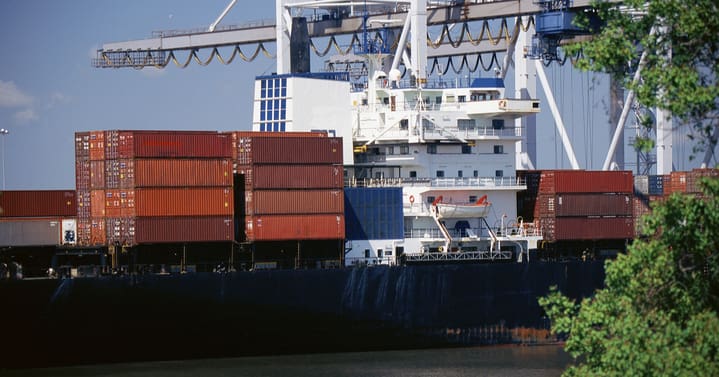LCL shipping, also known as less-than-container mode, makes up a large percentage of ocean freight seen within the global supply chain. As recovery continues at ports and cities around the globe, the risk of rolled ocean cargo and long port delays continues to plague major ports in the United States and other countries as well. At the same time, alternate ports of entry, like the Port of Savannah, are actively working to expand its TEU capacity, and accounting for congestion is essential to understanding when rolled cargo may occur. After all, there’s only so much space on any dock. Unfortunately, there’s a problem that’s often overlooked. Rolled cargo is easier to justify for full container loads (FCL), but many many underestimate the value of LCL as its own mode too.
Congestion and risk for rolled cargo has become an everyday sight at ports such as Los Angeles and Long Beach to see thirty or more vessels waiting for openings to unload cargo. However, what can be seen from the shorelines tells only a partial picture.
As pointed out in a recent piece by The Wall Street Journal, “More than 60 other [vessels] destined for the port complex remained in waters farther out to sea, some hundreds or even thousands of miles away, including ships that reduced speed during their voyage from Asia to delay their arrival.” With so much uncertainty and a high chance for disruptions and delays, the focus on mitigating FCL and LCL shipping risks and improving drayage service has become more vital than ever. And part of that includes working with an expert in drayage service to reduce overall risk of rolled cargo too.
What’s the Less-Than-Container Load Definition?
LCL shipping is a specialized form of transportation, by cargo container usually, where multiple orders or a diverse range of products fill shipping containers. When shipping a small volume of stock by container ship, it almost always ends up being much more economical to combine deliveries into containers with other customers and other orders going to the same port or warehouse hub. While it is an innovative and helpful form of transportation, there are several risks involved with LCL transportation that make it less prone to rolling and delays. A lack of visibility and similar container monitoring and tracking issues also currently plague ocean freight transportation and shipping chains across the globe. But ultimately, the less-than-container load means more shipments for different shippers, which will require deconsolidation when the ship reaches the destination.
Planning Is Integral to LCL and Mitigating Delays Too
Cargo rolling happens quite frequently, with some containers shifting to different vessels multiple times before reaching the final destination. Rolled ocean cargo can occur for many reasons. However, the most common usually has to do with a ship being overbooked or having routing changes that take it away from the intended port of destination. LCL shipping loads are more likely to experience rolling because when multiple shipments and customers have goods in a single container, it significantly reduces where and even when that container can be dropped off and what other options exist for getting it delivered. This is why an innovative TMS integration and onboarding system is critical to LCL transportation success.
Furthermore, if the LCL shipment can be moved to a short-term storage facility near the port, it’s faster to unload and get the empty container back to the port. In other words, LCL freight with faster unloading means more dual transactions, creating a win-win for everyone involved.
How to Mitigate Risk of Both FCL and LCL Rolled Cargo
Understanding the intricacies of less-than-container load definition and involvement is only part of the challenge facing ocean freight shippers and brokers. Mitigating rolled cargo in both FCL and LCL shipping involves careful consideration of the following:
- Know real-time container status to better plan routes and compensate for delays and issues at the last minute.
- Plan drayage well in advance to help offset delays and holdups before containers even make it to port.
- Account for delays in transit caused by weather, vessel problems, cargo rolling, and other delays and disruptions.
- Have a plan for deconsolidating multiple LCL shipments, using a local warehouse wherever possible too, which alleviates dwell time for drivers.
- Improved visibility for shippers to know the current status of all containers and shipments with reliable on-demand data.
- Ensure all cargo has proper customs clearance documentation and follow all legal protocols to avoid possible delays.
- Expect a certain degree of rolled ocean cargo as inevitable and plan for ways to tighten up shipping times in other areas.
- Keep open lines of communication between team members and other involved parties with real-time data sharing and reporting.
Improve LCL and FCL Freight Management With the Right Logistics Partner
Dealing with rolled ocean cargo requires a certain level of visibility and insight that many shippers currently lack. According to The Journal of Commerce, “demand for guaranteed vessel space is expected to further drive shippers toward less-than-containerload services that saw double-digit percentage volume growth in the first quarter.” LCL shipping is likely to become more commonplace in the years ahead, which means rolling and other issues must be properly planned for in advance. Connect with PortCity to learn more about how your team can improve import drayage service, LCL shipping deconsolidation, and boost throughput today.
